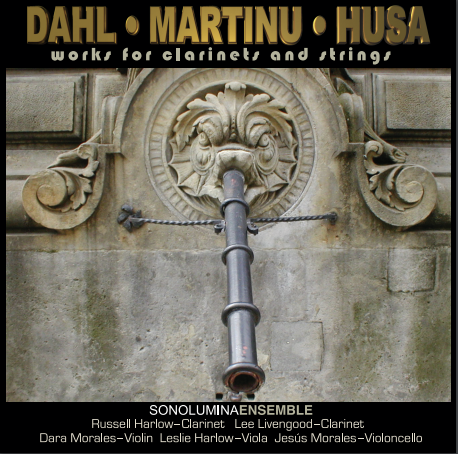featuring clarinetists Russell Harlow and Lee Livengood, violinist Dara Morales, violist Leslie Harlow and cellist Jesús Morales
Formats: Audiophile Super Audio Compact Disc, will also sound great on a regular CD player: $40.00 plus tax and shipping

$40.00 USD
plus tax and $5 shipping
View the album booklet in .PDF format
Concerto a Tre by Ingolf Dahl
1. 18.34
Dara Morales–Violin, Russell Harlow–Clarinet, Jesús Morales–Violoncello
The “Concerto a Tre” for Violin, Clarinet and Cello, one of the most attractive examples of neoclassicism, was written in 1947 for clarinetist Benny Goodman, violinist Eudice Shapiro and cellist Victor Gottlieb. Ingolf Dahl, born in Hamburg, Germany, on June 9, 1912, became a prominent American composer, pianist, conductor, and educator. Born to Swedish parents, he studied with Philipp Jarnach at the Cologne Hochschule für Musik in Cologne, Germany from 1930 to 1932. Fleeing Germany as the Nazi Party was coming to power, he continued his studies at the University of Zürich with Volkmar Andreae and Walter Frey. Dahl emigrated to the United States in 1938, settling in Los Angeles and joining the community of expatriate musicians that included Ernst Krenek, Darius Milhaud, Arnold Schoenberg, Igor Stravinsky, and Ernst Toch. Ingolf Dahl became a naturalized U.S. citizen in 1943 and in 1945 he joined the faculty of the University of Southern California in Los Angeles, where he taught until his death in 1970. Among Dahl’s honors are two Guggenheim Fellowships, two Huntington Hartford Fellowships, an Excellence in Teaching Award from the University of Southern California, and the ASCAP Stravinsky Award.
Serenade for Two Clarinets, Violin, Viola and Violoncello, H. 334 by Bohuslav Martinu
- Moderato poco allegro – 4:33
- Andante – 5:33
- Allegro (poco) – 5:52
- Adagio – Allegro – 7:49
Russell Harlow–Clarinet, Lee Livengood–Clarinet, Dara Morales–Violin, Leslie Harlow–Viola, Jesús Morales–Violoncello
The “Serenade for Two Clarinets, Violin, Viola and Violoncello, H. 334” is a late work (1951) in four movements and is an excellent example of Martinu’s sense of traditional Czech classical idioms combined with his exceptionally original harmonic and melodic language. Bohuslav Martinu was born in a bell tower in the town on Poliãka, Bohemia, where his father (a shoemaker by trade) was a watchman. As a child he developed a local reputation, giving his first public concert in his hometown in 1905. In 1906 he became a violin student at the Prague Conservatory, where he studied briefly before being dismissed for “incorrigible negligence.” After leaving the Conservatory, he continued his studies on his own. Martinu spent the First World War in his home town as a teacher, where he pursued his interests in composition and joined the Czech Philharmonic Orchestra as a violinist. After his ballet Istar was completed in 1922, Martinu left Czechloslovakia for Paris, where he became a pupil of Albert Roussel. In the late 1930’s Czechoslovakia, under German occupation, was constantly demanding Martinu’s return from Paris. Martinu knew what this political demand meant and refused to comply. Realizing the Germans would soon occupy France, Martinu secured a visa to travel to the United States. Charles Munch and other prominent Americans worked to obtain the all-important visa for Martinu’s escape from Paris before the Nazi’s arrival in France. On June 11, 1941, the day of the German arrival in Paris, Martinu received his American visa and left on a train for Vichi, France, leaving most of his manuscripts and other belongings behind. From Vichi, Martinu left for Boston where he was warmly welcomed and his music was performed by the Boston Symphony and other important musical organizations. He settled in New York with his French wife. After the war, Martinu was considered a hero in his home country and was asked to accept a teaching position at the Czech Conservatory, the same school that expelled him as a student. Martin spent his later years in Switzerland, never returning to his homeland. Martinu died in Liestal on August 28, 1959.
Evocations de Slovaquie by Karel Husa
- La Montagne (The Mountain) – 5:19
- La Nuit (Night) – 4:51
- La Danse (Dance) – 4:38
Russell Harlow–Clarinet, Leslie Harlow–Viola, Jesús Morales Violoncello
“Evocations de Slovaquie” is a three movement work, with the movements entitled “The Mountain,” “Night” and “Dance.” The movements, at times reminiscent of the music of Kodaly, take listeners on contemporary journeys through the traditional Slavic idioms. Karel Husa was born on August 7, 1921, in Prague, Czechloslovakia. He learned to play the violin and the piano in early childhood and, after passing his final examination at high school, he enrolled in the Prague Conservatoire in 1939. At the Conservatory he studied in a class of Jaroslav Ridky, a Czech composer with traditional leanings. Husa attended courses in conducting led by Metod Dolezil and Pavel Dedecek. After the end of the Second World War, Husa was admitted to the graduate school of the Prague Conservatoire, where he attended courses led by Jaroslav Ridky, graduating in 1947. Husa decided to continue his studies of composition and conducting in Paris. He studied composition with Arthur Honegger and Nadia Boulanger and conducting with Jean Fournet, Eugene Bigot and Andre Cluytens. After finishing his courses in conducting at Ecole Normale de Musique de Paris and at Conservatoire de Musique de Paris Husa embarked on his musical career during which time he conducted the world’s leading orchestras and participated in many compositional projects. He divided his time between composing and conducting, taking an ever more active part in Parisian and international musical life. Husa’s First Quartet marked a big step on the composer’s path to the realm of international music: the Quartet received the 1950 Lili Boulanger Prize and the 1951 award at the music festival in Bilthoven in the Netherlands. Other compositions written by Karel Husa during his stay in Paris include the Divertimento for String Orchestra, the Concertino for Piano and Orchestra,“Evocations de Slovaquie,” Musique Diamateurs and the Portrait for String Orchestra. His String Quartet No. 3 won the Pulitzer Prize in 1969. Husa was a professor at Cornell University from 1954 until 1992 and resides in Ithaca, New York.
Click here to read reviews of this album.
About the IsoMike™
IsoMike™ (“Isolated Microphones”) is an experimental acoustic baffle system, designed to remedy the interference of intrachannel sounds that results in compromised fidelity recordings. For this 4–channel recording, the microphones were suspended on four arms, separated by IsoMike baffles. The largest heart-shaped baffle separated the right/left acoustic of the front microphones, the egg-shaped baffles separated the right/left rear microphones. Under the fabric shell of each baffle is a complex mechanical design that takes over 100 hours to construct. Most baffles absorb sound from mid- to high-range frequencies; lower frequencies are more difficult to absorb. Here, the unique shapes of the IsoMike™ baffles are advantageous. as lower frequencies flow around the heart- or egg-shaped baffles, they are scattered, effectively dissipating their energy. As a result, the microphones are much more sensitive–they will pick up extreme acoustic detail. We took great care, therefore, to reduce the noise level within the auditorium during the recordings.
Ray Kimber, owner
Recording/ Mastering Equipment
Recorders:
Tascam DS-D98HR & DV-RA1000
www.tascam.com
Microphone Preamp:
Millennian Media HV-3D custom
www.mil-media.com
Microphones:
DPA 3529A
www.dpamicrophones.com
5.1 Monitor Controller &
Reference Headphone Amplifier:
Grace Design M906 & M902
www.gracedesign.com
DSD Workstation:
Pyramix DSD
www.merging.com
Recording Workstation:
Genex GX9000
www.genexaudio.com
Converters:
EMM Labs ADC8 MkIV
EMM Labs DAC8 MkIV
www.emmlabs.com
Headphones:
HD-650
www.sennheiserusa.com
Monitor Speakers:
Lipinski Sound L707
www.lipinskisound.com
Magnepan 20.1
www.magnepan.com
B&W 800D Loudspeakers
www.bwspeakers.com
Amplifiers:
Pass Labs X350.5
www.passlabs.com
Bel Canto REF 1000 Amplifiers
www.belcantodesign.com
Cables:
Kimber Kable Select Series
www.kimber.com
Note:
Evocations de Slovaquie by Karel Husa
We are aware that there may have been something
lost in the translation of the title. The track names
used are as on the published English language score.
